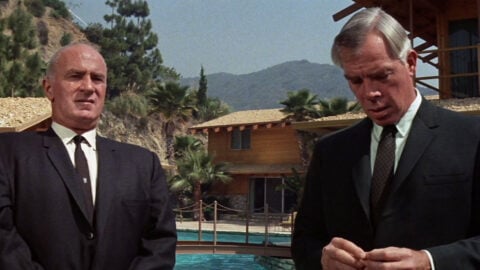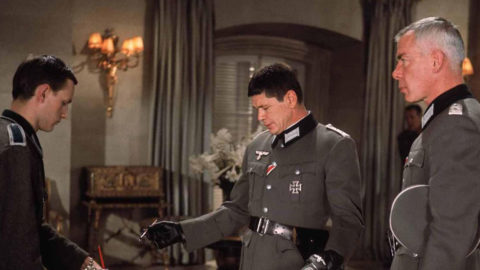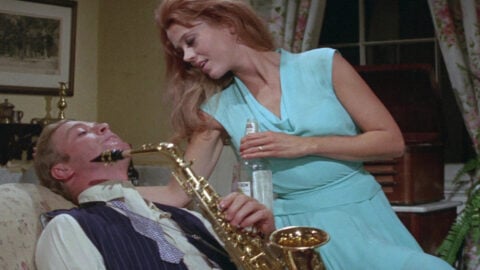Cinema ’67 Revisited: Cool Hand Luke
In my 2008 book Pictures at a Revolution, I approached the dramatic changes in movie culture in the 1960s through the development, production, and reception of each of the five nominees for 1967’s Best Picture Academy Award: Bonnie and Clyde, The Graduate, In the Heat of the Night, Guess Who’s Coming to Dinner, and Doctor Dolittle. In this biweekly column, I’m revisiting 1967 from a different angle. As the masterpieces, pathbreakers, and oddities of that landmark year reach their golden anniversaries, I’ll try to offer a sense of what it might have felt like to be an avid moviegoer 50 years ago, discovering these films as they opened.
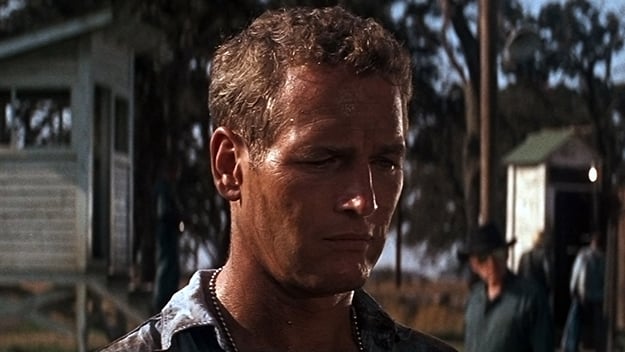
It is one of the enduring paradoxes of 1967 movie culture that, just as the generation gap threatened to widen into a chasm, a 42-year-old actor reinvented himself as an icon of alienation, rebellion, individualism, and protest for college-age moviegoers. Actually, for Paul Newman, Cool Hand Luke was less a reinvention than a culmination; as Roger Ebert, then 26, pointed out, the movie completed “a cycle of five films over six years”—the others he placed in the sequence were The Hustler, Hud, Harper, and Hombre—that had “something to say about the current status of heroism.” Or of antiheroism: in an interview shortly before the film began production, Newman told then–New York Times writer Peter Bart that he was about to play “the ultimate nonconformist and rebel. He’s the guy who beats the system.” And Newman’s portrayal of Lucas Jackson, a ne’er-do-well whose drunken night spent vandalizing parking meters lands him behind bars for a two-year stint on a Florida chain gang, became, for moviegoers of that moment, as iconic a character as Clyde Barrow, Virgil Tibbs, or Benjamin Braddock.
Cool Hand Luke will frustrate any film historian who believes that the only way to understand the explosion of creativity in American filmmaking that began in the late 1960s is auteurism. This was the first studio feature for director Stuart Rosenberg, and, although he would go on to make a dozen more (including Brubaker, another well-received drama set within the Southern penal system), he was no Arthur Penn or Mike Nichols—most of his workmanlike features would not touch the success or artistry of his debut. Rather, Cool Hand Luke plays as the work of a large and varied team of “authors” in various areas of craft who would go on to define the style and look of ’60s and ’70s New Hollywood movies. Besides Newman, who, as Ebert noted, was taking an active hand in shaping and developing a fairly consistent character archetype over several years and films, they included co-screenwriter Frank Pierson, who would go on to write Dog Day Afternoon; cinematographer Conrad Hall (In Cold Blood, Butch Cassidy and the Sundance Kid, Fat City, Marathon Man); editor Sam O’Steen (Carnal Knowledge, Chinatown); and sound mixer Larry Jost, who would work with O’Steen on those two films and then go on to One Flew Over the Cuckoo’s Nest—a movie that is in many ways Cool Hand Luke’s spiritual cousin. Both films are about outsiders pulled unwillingly into a punitive closed society; they learn the rules of their new captivity brutally from both their captors and their fellow inmates, but their innate spirit—the fact that they haven’t been ground down yet—makes them natural leaders. In the end, it’s the loner versus the system; when Newman said he beats it, maybe he hadn’t read the script all the way through.
The Production Code Authority did read the script, and, although it was breathing its last, it could still, in late 1966, rouse itself to a state of high dudgeon. “There [is] entirely too much profanity for us to begin to consider approving the script,” a PCA representative wrote in a memo to Luke’s production team, including “by actual count…son of a bitch (4), God damn (6), bastard (8), damn (32), hell (39), and other assorted expressions such as grab ass, wise ass, smart ass, raggedy ass, shove it, and bitched up… There were several sequences which, as presently described, appear to us to be unacceptably brutal, savage and sadistic.” But mores were changing so rapidly that, by the time the movie was released a year later, there was little the Code could do about the film’s language, or about the bare butts that, for one of the first times in an American studio movie, appear casually on screen. Those weren’t the only novelties in Cool Hand Luke; every aspect of it, from the sweaty, dust-choked palette to the notes of wry futility that pervade every scene, represents the rejection of studio norms and the heralding of a new age in American filmmaking.
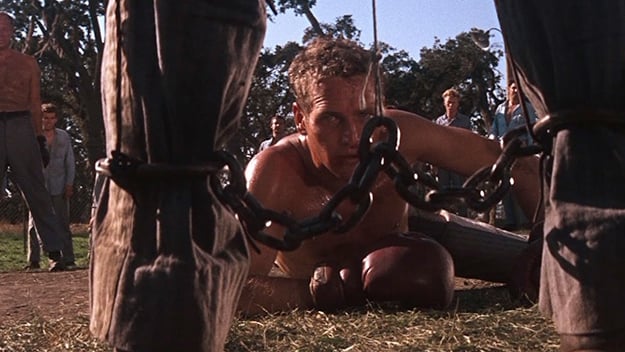
Nevertheless, there are some ways in which Cool Hand Luke, half a century on, shows its years. A sequence in which the chain-gang workers lustily ogle a big-breasted blonde soaping down first a car and then, obligingly, herself, vaults past “problematic” and straight to laughably appalling. And the film’s handling of race is, though well-intentioned, awkward in ways that are characteristic of the period; nothing is made of the fact that the prison work team is apparently segregated, and black characters appear only when Newman’s Luke escapes and interacts briefly with a pair of African-American children, a moment intended to suggest (as a similar sequence did in Bonnie and Clyde) that white outlaws and average black Americans should join forces against their common enemy: The Man.
Politically, Cool Hand Luke is sometimes specific, sometimes less so. In its early sequences, and in the conflict between Luke and the sadistic chief played by Strother Martin that provided the film’s most memorable line (“What we’ve got here is failure to communicate”), the film feels like an unmistakable, generationally targeted indictment of police brutality. And the arc of the movie, in which Luke is indoctrinated into an all-male world of regimentation, brutality, and the following of orders that can seem bafflingly pointless, marks it as one of the earliest American studio films to function as a sustained Vietnam War allegory. But in other ways, Cool Hand Luke is vaguer about what it stands for—it’s the beginning of a decade-long run of films in which being an individualist is valorized in the absence of any particular information about exactly what kind of an individualist a character is, or why. We know very little about Luke other than that he comes from a rough background and doesn’t like to play by the rules; by the end of the movie, alienation seems to be his actual goal rather than a result of his circumstances, and despite the number of times (too many) that Rosenberg positions him in Christ-like poses of agony, we’re not sure exactly which of our sins he’s dying for.
What holds the film together, irresistibly, is Newman, who was unmatched at creating characters who were at once romantic and cynical, hard-bitten and yearning, idealistic and self-destructive. No American actor has ever embodied wounded, confused masculinity with more skill or grace; you want to know Luke even as he pulls away from everyone and into himself, and his struggle to get wherever he’s trying to go remains vivid and moving. In the hands of its many craftsmen, Cool Hand Luke, wrote the critic Wilfrid Sheed in his essay “The Movie South,” has “perfect pitch…[it’s] a faithful scale study of what it’s like to be in a power situation where the script-writer won’t help you.” As a guide into that particular limbo, Newman is, even half a century later, peerless.
How to see it: Cool Hand Luke is available on DVD and Blu-ray and streams on Amazon, YouTube, iTunes, and other major services.
Mark Harris is the author of Pictures at a Revolution: Five Movies and the Birth of the New Hollywood (2008) and Five Came Back (2014).



